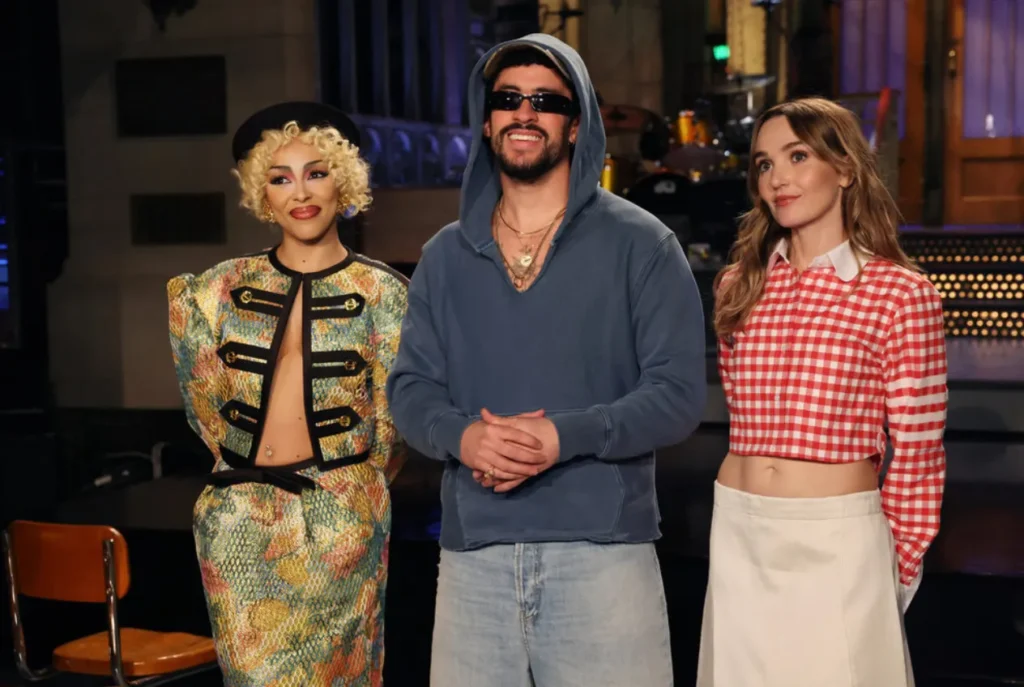The Night Bad Bunny Took the SNL Stage
On October 4, 2025, Bad Bunny hosted the season premiere of Saturday Night Live. For millions tuning in, the expectation was a night of sketches, musical numbers, and celebrity cameos. What they received instead was something more resonant. From his opening monologue, the Puerto Rican superstar turned a late-night stage into a cultural pulpit, responding to weeks of backlash against his appointment as headliner for the 2026 Super Bowl halftime show.
Rather than sidestep controversy, Bad Bunny addressed it head-on, with humor, conviction, and a deliberate blend of English and Spanish. In doing so, he marked a turning point—not only in his career but in the ongoing conversation about representation, identity, and belonging on America’s most watched stage.
The Backlash Before the Spotlight
When the NFL, Roc Nation, and Apple Music announced Bad Bunny as the halftime performer, conservative pundits immediately objected. The pithy of the criticism was couched in language politics: how could someone who performs almost exclusively in Spanish represent America’s biggest television event? Commentators mocked his lyrics, questioned his cultural relevance, and in some cases, went further, invoking immigration rhetoric despite his clear status as a U.S. citizen by virtue of being Puerto Rican.
This reaction revealed a deep anxiety around cultural plurality. While the Super Bowl halftime show has often featured diverse performers—from Shakira and Jennifer Lopez to The Weeknd—the idea of a Spanish-dominant artist at the center of the spectacle struck some as a step too far. The backlash revealed more about the critics’ discomfort than about Bad Bunny himself.
View this post on Instagram
Turning Satire into Counterattack
Bad Bunny opened his SNL monologue with satire. With a mischievous grin, he told the audience, “I’m doing the Super Bowl halftime show. I’m very happy, and I think everyone is happy about it—even Fox News.” What followed was a montage of conservative pundits edited to absurdly proclaim him their “favorite musician” and “the next president.”
The humor was sharp, mocking those who had spent the week belittling his artistry. More importantly, it set a tone: he would not meet his critics with apology but with playfulness, exposing the fragility of their arguments by making them ridiculous.
A Win for All Latinos
After the joke came a shift in tone. Speaking in English, he addressed the significance of the halftime slot. “I know people all around the world who love my music are also happy, especially all of the Latinos and Latinas here in the United States. It’s more than a win for myself—it’s a win for all of us.”
This reframing was vital. It took the halftime show beyond personal achievement and positioned it as collective representation. In a single line, Bad Bunny aligned himself with millions of Spanish-speaking Americans who rarely see themselves reflected at the center of national entertainment.
Switching Languages, Raising Stakes
Then came the pivot that defined the night. He transitioned into Spanish, his cadence deliberate, his gaze unwavering: “Más que un logro mío, es un logro de todos nosotros. Demostrando que nuestra huella y nuestra contribución en este país no la podrá quitar ni borrar nadie.”
The message was clear: Latinx contributions in the United States are indelible. No amount of rhetoric can erase them. And then came the line that ricocheted across social media within minutes: “If you didn’t understand what I just said, you have four months to learn.”
It was a dare and a declaration rolled into one. Bad Bunny wasn’t offering an apology for his Spanish lyrics. He was demanding adaptation. The expectation of assimilation was inverted—English-speaking audiences were asked to meet him halfway.
Why This Matters
This was the first time Bad Bunny publicly confronted the MAGA-fueled criticism surrounding his halftime role. Until then, he had remained silent, allowing speculation to swirl. On SNL, he drew a line in the sand, signaling he would not dilute his identity for comfort.
The halftime show has always been more than music. It is where cultural anxieties and artistic expression collide, where spectacle becomes a mirror for American society. By speaking in Spanish on one of the country’s most iconic comedy stages, Bad Bunny reminded audiences that America is multilingual, multiracial, and inseparable from Latinx identity.
Super Bowl as Political Theater
The Super Bowl halftime show has long carried political resonance, whether explicit or implied. Michael Jackson’s 1993 performance cemented the modern halftime spectacle as cultural ritual. Beyoncé’s 2016 set invoked Black Lives Matter imagery and sparked outrage from police unions. Shakira and Jennifer Lopez’s 2020 performance was seen as a celebration of Latin identity against a backdrop of anti-immigrant policies.
In this tradition, Bad Bunny’s monologue becomes a preview of what’s to come. By insisting that audiences learn Spanish if they want to understand him, he hinted that the halftime show will not conform to monolingual expectations. Instead, it will reflect the linguistic and cultural reality of America in 2026.
Risks and Expectations
The path forward is not without risks. The NFL, its sponsors, and its broadcast partners are historically cautious about political controversy. Performers have faced censorship or intense scrutiny for perceived political gestures. Bad Bunny will have to navigate these pressures carefully.
Yet his monologue shows he is prepared for the backlash. He has chosen authenticity over appeasement, signaling that he will not soften his cultural expression for mass appeal. The halftime show may therefore become one of the most politically charged performances in recent memory, whether through symbolism, language, or sheer presence.
Audience Divides
The immediate reaction to his SNL appearance revealed the divides in cultural reception. Fans celebrated his confidence, flooding social media with memes celebrating the “four months to learn” line. They praised him for refusing to bow to pressure, interpreting his words as a rallying cry for Latinx pride.
Critics, on the other hand, doubled down. Some accused him of politicizing entertainment, others of alienating audiences. Yet his monologue was not exclusionary—it was an invitation, albeit a pointed one. To learn Spanish was to broaden horizons, not to shut doors.
A Global Artist on America’s Biggest Stage
Bad Bunny’s presence at the Super Bowl represents more than just a booking. It is the culmination of a career that has redefined global pop. He has topped charts across continents, performed in sold-out stadiums worldwide, and brought reggaetón and Latin trap into the mainstream. His halftime performance is not an aberration—it is the logical next step.
For some, this challenges their notion of what American entertainment should be. For others, it represents the inevitable evolution of culture. Either way, the moment will be historic.
Impression
Bad Bunny’s SNL monologue will be remembered not for its jokes but for its defiance. In a few short minutes, he mocked his critics, affirmed his community, and reframed the debate around his halftime show. By telling America it had four months to learn Spanish, he flipped the narrative, demanding adaptation rather than assimilation.
The Super Bowl halftime show in February 2026 will not just be a concert. It will be a cultural reckoning, a performance that reflects the complexities of American identity in an era of division. Bad Bunny has made it clear: he will not back down, he will not apologize, and he will not perform on anyone’s terms but his own.
What he demonstrated on Saturday Night Live was courage—the courage to face criticism with humor, to claim space with pride, and to remind the world that culture is not static but ever-expanding. When the lights go up in February, those four months will have passed. Whether the audience learned or not, Bad Bunny will be ready.
No comments yet.








